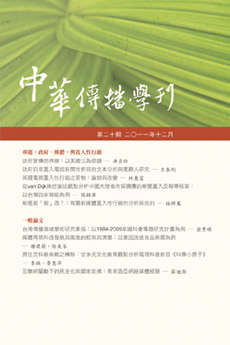 閱覽人數: 33
閱覽人數: 33
December
2011
No. 20
政府、媒體,與置入性行銷
Government, Media, and Product Placement頁數:25 - 43
作者(中)
王泰俐
作者(英)
Tai-Li Wang
關鍵詞(中)
新聞置入、詳論可能性模式、置入策略、閱聽人效果
關鍵詞(英)
product placement, elaboration likelihood model, governmental embedded message, online audience research
中文摘要
本文探究未來可能容許以標示「廣告」的方式繼續進行置入行銷的三類廣義的新聞資訊性節目,包括深度報導、新聞政論性節目以及談話性節目,並鎖定爭議性最高的政府訊息置入,分別以文本分析以及線上閱聽人研究兩種研究方法,探究政府訊息置入這三類節目的置入策略、效果以及未來可能引發的爭議。
研究結果發現,一般性政策傾向以感性或輕鬆口吻,搭配精緻的畫面與後製效果的邊陲路徑策略,進行政府訊息的軟性行銷。而爭議性政策的置入較傾向以中央路徑策略呈現核心訊息,並以「賽事」框架來包裝爭議政策。
閱聽人研究則顯示,不管從新聞專業性評價、收視欣賞品質或者傳播效果而言,深度報導與政論性節目,與一般談話性節目三種文類間,存在明顯差異。未來在認定「新聞性節目」的過程中,應該考量深度報導與政論節目不同於一般談話性節目,應受新聞不得置入的規範。而一般談話性節目的置入,也應該重視專業性與可信度,清楚標示「廣告」並明示贊助單位,讓新聞置入的資訊在閱聽眾面前透明化。
研究結果發現,一般性政策傾向以感性或輕鬆口吻,搭配精緻的畫面與後製效果的邊陲路徑策略,進行政府訊息的軟性行銷。而爭議性政策的置入較傾向以中央路徑策略呈現核心訊息,並以「賽事」框架來包裝爭議政策。
閱聽人研究則顯示,不管從新聞專業性評價、收視欣賞品質或者傳播效果而言,深度報導與政論性節目,與一般談話性節目三種文類間,存在明顯差異。未來在認定「新聞性節目」的過程中,應該考量深度報導與政論節目不同於一般談話性節目,應受新聞不得置入的規範。而一般談話性節目的置入,也應該重視專業性與可信度,清楚標示「廣告」並明示贊助單位,讓新聞置入的資訊在閱聽眾面前透明化。
英文摘要
This research focuses on three types of TV news programs, including indepth reporting, news talk shows, and general talk shows, which might be allowed to continue product placement practice in the form of “commercials” after new budget laws are passed. This study uses textual analysis and online-audience research to target governmental embedded messages, to examine the strategies of these highly contentious messages, their potential effects, and possible contentions in the future.
This research has shown that general policy messages tend to be softly marketed in product messages in a “peripheral approach strategy.” This strategy features sentimental and entertainment-oriented tones, sophisticated pictures, and post-production effects. Policy messages that are more controversial tend to be presented in a “central approach strategy,” which characterizes central messages in a “racing frame” of news storytelling.
Online-audience research confirms previous findings that in-depth reporting and news talk shows should differ from general talk shows by new regulations, and should refrain from news product placements. General talk shows should clearly state the sponsor and the commercial status of program messages to maintain media professionalism and public trust.
This research has shown that general policy messages tend to be softly marketed in product messages in a “peripheral approach strategy.” This strategy features sentimental and entertainment-oriented tones, sophisticated pictures, and post-production effects. Policy messages that are more controversial tend to be presented in a “central approach strategy,” which characterizes central messages in a “racing frame” of news storytelling.
Online-audience research confirms previous findings that in-depth reporting and news talk shows should differ from general talk shows by new regulations, and should refrain from news product placements. General talk shows should clearly state the sponsor and the commercial status of program messages to maintain media professionalism and public trust.